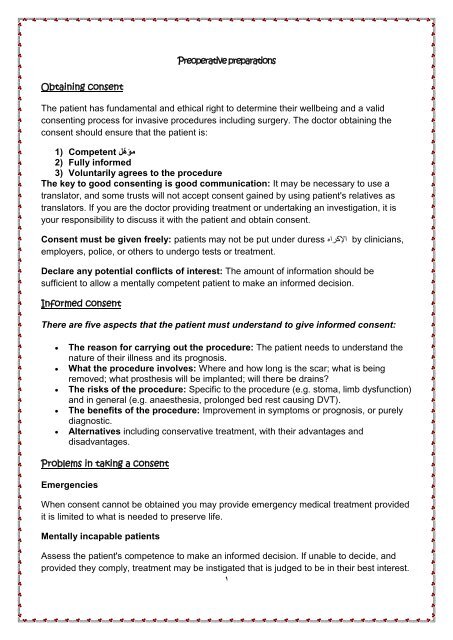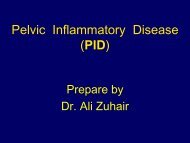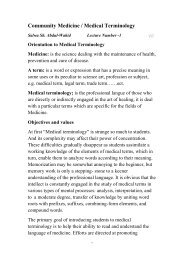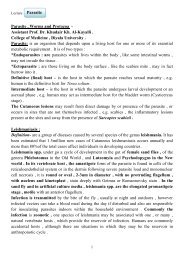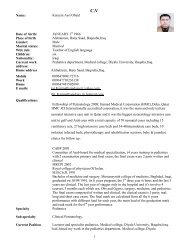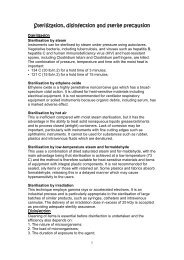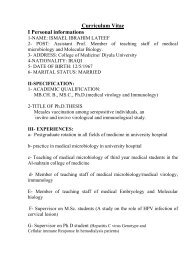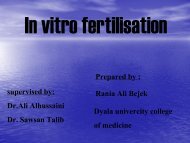Preoperative preparations Obtaining consent The patient has ...
Preoperative preparations Obtaining consent The patient has ...
Preoperative preparations Obtaining consent The patient has ...
- No tags were found...
You also want an ePaper? Increase the reach of your titles
YUMPU automatically turns print PDFs into web optimized ePapers that Google loves.
<strong>Preoperative</strong> <strong>preparations</strong><strong>Obtaining</strong> <strong>consent</strong><strong>The</strong> <strong>patient</strong> <strong>has</strong> fundamental and ethical right to determine their wellbeing and a valid<strong>consent</strong>ing process for invasive procedures including surgery. <strong>The</strong> doctor obtaining the<strong>consent</strong> should ensure that the <strong>patient</strong> is:مؤهّل 1) Competent2) Fully informed3) Voluntarily agrees to the procedure<strong>The</strong> key to good <strong>consent</strong>ing is good communication: It may be necessary to use atranslator, and some trusts will not accept <strong>consent</strong> gained by using <strong>patient</strong>'s relatives astranslators. If you are the doctor providing treatment or undertaking an investigation, it isyour responsibility to discuss it with the <strong>patient</strong> and obtain <strong>consent</strong>.Consent must be given freely: <strong>patient</strong>s may not be put under duress اإلكراه by clinicians,employers, police, or others to undergo tests or treatment.Declare any potential conflicts of interest: <strong>The</strong> amount of information should besufficient to allow a mentally competent <strong>patient</strong> to make an informed decision.Informed <strong>consent</strong><strong>The</strong>re are five aspects that the <strong>patient</strong> must understand to give informed <strong>consent</strong>:<strong>The</strong> reason for carrying out the procedure: <strong>The</strong> <strong>patient</strong> needs to understand thenature of their illness and its prognosis.What the procedure involves: Where and how long is the scar; what is beingremoved; what prosthesis will be implanted; will there be drains?<strong>The</strong> risks of the procedure: Specific to the procedure (e.g. stoma, limb dysfunction)and in general (e.g. anaesthesia, prolonged bed rest causing DVT).<strong>The</strong> benefits of the procedure: Improvement in symptoms or prognosis, or purelydiagnostic.Alternatives including conservative treatment, with their advantages anddisadvantages.Problems in taking a <strong>consent</strong>EmergenciesWhen <strong>consent</strong> cannot be obtained you may provide emergency medical treatment providedit is limited to what is needed to preserve life.Mentally incapable <strong>patient</strong>sAssess the <strong>patient</strong>'s competence to make an informed decision. If unable to decide, andprovided they comply, treatment may be instigated that is judged to be in their best interest.1
& is the breathing as good as it can be ?or is the <strong>patient</strong> in the middle of an exacerbation?.3) Cardiac disease. .Has the <strong>patient</strong> had a recent MI or does he <strong>has</strong> stable or unstable angina.4) Rheumatoid arthritis often associated with an unstable cervical spine, so a cervical spine X-rayis indicated..Also such <strong>patient</strong>s usually receive nonsteroidal anti-inflammatory drugs and steroids.5) Rheumatic fever or valve disease or the presence of prosthesis – necessitating prophylacticantibiotics.6) Sickle cell disease. A hemoglobin electrophoresis should be checked in areas wheresickle cell disease is more prevalent or if the history is suggestive.7) Chronic renal failure: In chronic renal failure (CRF) there is hyperkalaemia &the fluid balance is difficult to achieve. Uremia impairs platelets function but theeffect can be reversed using desompressin. Clearance of narcotics is poor andpostoperative narcosis should be reversed by the opiate antagonist naloxone.Patients with CRF may require dialysis prior to surgery.8) Hypertension and whether it is controlled or not and the type of the treatment used.9) Bleeding disorder or anticoagulation Patients with haemophilia A or B shouldbe given clotting factors replacement. Patients on warfarine should beconverted to heparin preoperatively. Where <strong>patient</strong>s are anicoagulated onaccount of previous thromboemoblic disease, additional prophylaisis should begiven, including measures such as compression stockings, intermittentcompression boots while on the operating table and early mobilization wherepossible.10) Any history of haematological diseases as thalasaemia ,autoimmune haemolytic anaemia ,etc.11) Adrenal problems as Cushing disease or Addison's disease.12) Previous history of jaundice ,history of viral hepatitis.Patients with obstructive jaundice often have prolonged prothrombin time andrequire vitamine K & or fresh frozen plasma prior to surgery to correct theabnormality.<strong>The</strong>y are also more prone to infection & poor wound healing.Intraoperatively it is important to maintain a diuretics & fluid replacement toprevent acute renal failure & hepatorenal syndrome. In the presence of liver impairment,metabolism of some commonly used drugs may be reduced.3
Past surgical history1) Nature of previous operations. What <strong>has</strong> been done before? What problems wereencountered at that time?2) Complications of previous operation e.g. DVT. Methecilline resistant staphylococcus aureus orwound dehiscence.Past anesthetic history:1) Difficult intubation (<strong>The</strong> <strong>patient</strong> may be told about this).2) Aspiration during anaeshesia may suggested delayed gastric emptying (e.g. due o Dm) suggestingthat a prolonged ,fast and air way protection (cricoid pressure) are indicated prior to induction.3) Scoline apnoea. Deficiency of pseudocholinesterase resulting in sustained paralysisfollowing short acting muscle relaxing as suxamethonium. It is usually inherited as an autosomaldominant &so there may be family history.4) Malignant hyperpyrexia. Rapid excessive rise in temperature with muscular rigidity often withrhabdomyloysis following induction of anaesthesia and carries a high mortality. It is inherited asautosomal dominant.Social habits1) Smoking: Ideally <strong>patient</strong>s should stop smoking fo 9 weeks before any general anesthesiato improve their respiratory function & reduce their thrombogenic potential.2) Alcohol: History of dependency should be sought & management of the preoperativeperiod using chlordiazepoxide to avoid acute alcohol withdrawal syndrome.3) Substance abuse: In particular i.v. drug usage, should be sought and appropriateprecautions taken. Such <strong>patient</strong>s are a high risk for transmission of hepatitis B, hepatitis C & HIV.4
DrugsMost drugs should be continued on admission. In particular drugs acting on the cardiovascular systemshould usually continued and given on the day of surgery.<strong>The</strong> following drugs are of surgical concern1) Warfarin: Where possible, should be stopped before surgery. If continued anticoagulationis required, then convert to heparin.2) Aspirin causes increased bleeding & should also be stopped where ever possible at least 10 daysbefore surgery.3) Steroids: Patients who are steroid dependent will need extra glucocorticoids in theform of intravenous hydrocortisone injections to help them overcome the perioperative stress.4) Immunosuppressive drugs: <strong>The</strong> <strong>patient</strong>s on such drugs are more prone for post operative infection.5) Diuretics. Both thiazide & loop diuretics cause hypokalaemia.6) Monoamine oxidase inhibitor. <strong>The</strong>y have important side effects e.g. hypotension when combinedwith general anaesthesia.7) Oestrogen-containing contraceptive pills (EOCP) increase the risk ofthromboembolic disease in women taking them prior to surgery. Progesterone-onlycontraceptives appear to pose little or no additional risk and may be continuedduring surgery.AllergiesAsk about allergy to * Anaesthetics * Antimicrobial drug * Skin preparation substancese.g. iodine * Wound dressings e.g. elastoblast.5
Patient assessment for anesthesiaAnesthetists commonly measure the severity of the <strong>patient</strong> comorbidity, and assess the risk ofanesthesia according to the American Society Anesthesia (ASA) scale: ASA I Healthy <strong>patient</strong>. <strong>The</strong> pathological process requiring surgery is localized, e.g.a fit young <strong>patient</strong> with an inguinal hernia. ASA II Mid to moderate systemic disease which may/may not be related to thepathological process requiring surgery,e.g. <strong>patient</strong> on medication for hypertension. ASA III Severe systemic disease limiting activity, e.g. a <strong>patient</strong> with angina onwalking 200 yards. ASA IV Severe systemic disease posing a constant threat to life, e.g. a <strong>patient</strong> withangina at rest. ASA V A moribund <strong>patient</strong> unlikely to survive 24 hours with or without surgery, e.g.an elderly <strong>patient</strong> with septic shock from perforated diverticular disease.Routine preoperative testingTestCommentComplete blood cell count Possibility of substantial blood loss, <strong>patient</strong>s withchronic illnesses or symptoms of anemiaUrinalysisUrologic symptoms, instrumentation of the urinarytract, possibility of surgical placement of prostheticmaterialsSerum electrolytes, Age >50, chronic diarrhea, renal disease, livercreatinine, and blood urea disease, diabetes, CHF or other cardiac disease,nitrogenhypertension (HTN), major procedure, diuretic use,digoxin use, ace inhibitor useCoagulation studiesBiochemical profiles(including liver enzymes)Pregnancy testingChest x-rayElectrocardiogramFamily history of bleeding disorder, <strong>patient</strong> history ofabnormal bleeding, anticoagulant usage, liver disease,malnutrition, chronic antibioticsHistory of liver or biliary disease. (Albumin strongpredictor of perioperative morbidity and mortality,should be considered for major procedures.)Any woman of childbearing age (exceptposthysterectomy <strong>patient</strong>s)Acute cardiac or pulmonary symptomsMen >40, women >50, history of cardiovasculardisease or arrhythmia, diabetes, HTN6
Type and cross/type andscreenNone if very low risk of blood loss. Type and screen ifrisk of substantial blood loss is low to moderate; typeand cross if moderate to high risk of substantial bloodloss7


